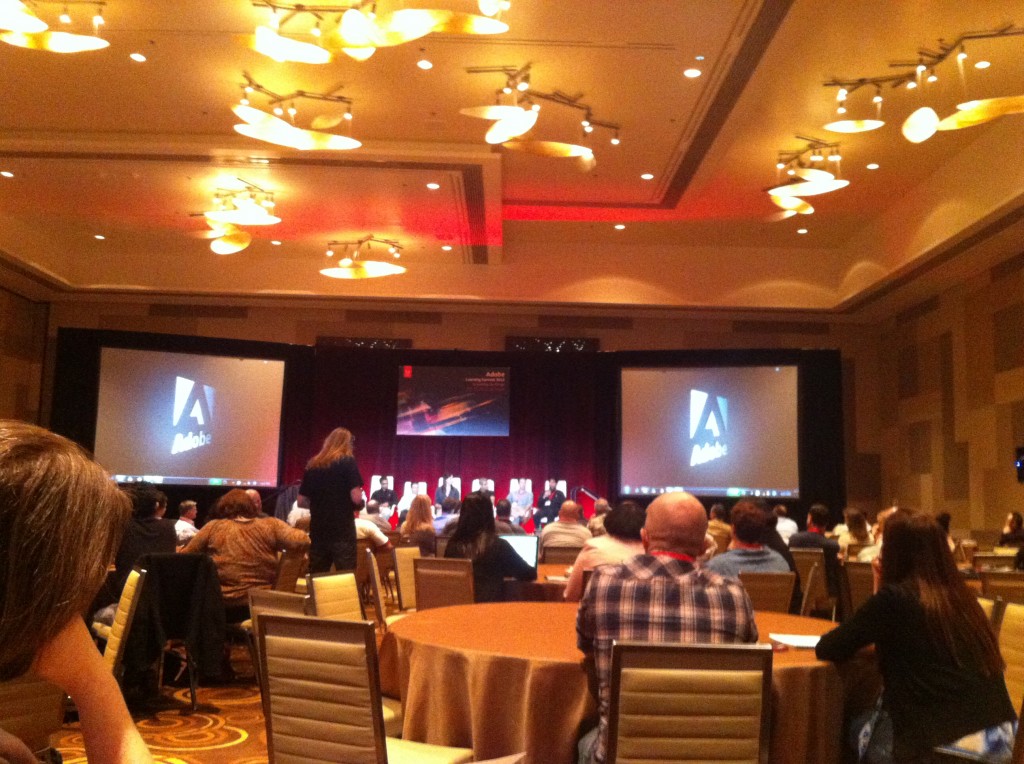Monday saw the Adobe Learning Summit in Las Vegas. The lion’s share of GuyKat production is done using Adobe tools, given they’d scheduled the event the day before the DevLearn 2012 conference it made sense for us to be there.
These summits are always great for signposting the way technology is drifting. Vendors share their roadmaps, latest thinking and showcase alpha version products. Unsurprisingly there was quite a bit of focus on how to output content to HTML 5 During the panel session the Adobe folk came under some fire from the audience over their mixed messages on long term commitment to Flash. Whilst every vendor is shouting that their latest products output content in both Flash and HTML 5 the ugly reality is that dual-output workflows force you to ‘dumb down’ to the current lowest common denominator of supported features. Whatever vendors boast the fact is the feature sets the main development tools currently output to Flash are not fully supported in HTML5. So whilst HTML5 may well represent steps forward in the future developing for it at the moment feels like taking several steps backwards.
It’s clear that Adobe are grappling with this and there were a few teasers and show-and-tells of products in development to ease the issue. The next few years of transition between technologies are going to be a pain in the backside for the industry. The first vendor that can get a product to market that truly delivers the full feature set of an Adobe Captivate or Articulate Storyline product in HTML5 output will clean up. Such a magic solution still looks years away. In the meantime, whilst the technology gurus grapple with this, GuyKat are going to continue to create our full featured content using our existing technologies. We see no advantage in being ‘bleeding edge’. We can and will develop for the iPad when specifically commissioned to do so, but given that the overwhelming majority of our content is intended to be consumed on the desktop, we’ll develop for that environment without compromise.
One thing that did excite at the conference was some demos from the fabulous Aussies from Infosymantics. They develop plug-ins for the Captivate platform to extend out-of-box functionality. We’ve used their stuff in the past to help us rapidly reduce the development time for things like drag-and-drop games. They gave some cool demos of what they’re working on. Safe to say, as soon as these are released we’ll aim to be the first to implement them and we’re looking forward to be able to ramp up our output another level without any impact on development time or cost to the client.



Your point of view caught my eye and was very interesting. Thanks. I have a question for you. https://accounts.binance.com/ph/register-person?ref=JHQQKNKN
Your article helped me a lot, is there any more related content? Thanks!
Thank you for your sharing. I am worried that I lack creative ideas. It is your article that makes me full of hope. Thank you. But, I have a question, can you help me?
Your article helped me a lot, is there any more related content? Thanks!
Thank you for your sharing. I am worried that I lack creative ideas. It is your article that makes me full of hope. Thank you. But, I have a question, can you help me?
Can you be more specific about the content of your article? After reading it, I still have some doubts. Hope you can help me.
Your point of view caught my eye and was very interesting. Thanks. I have a question for you.
I don’t think the title of your article matches the content lol. Just kidding, mainly because I had some doubts after reading the article.